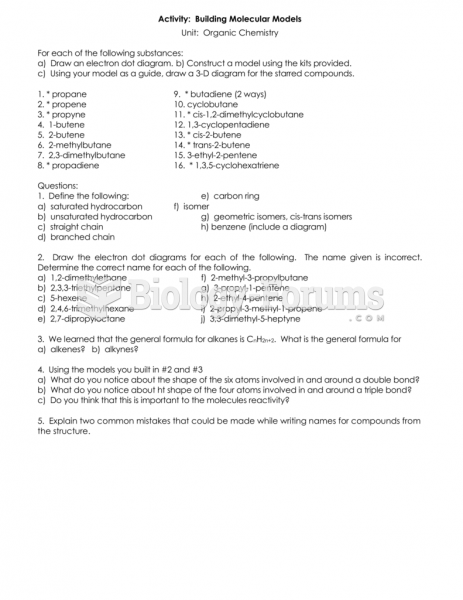Read the memo and respond to the questions that follow by choosing the letter of the correct
answer.
MEMORANDUM
To: All Employees
From: Building Safety and Maintenance
Date: March 15, 20
Subject: Procedures for Dealing with Chemical Splashes on Skin
The purpose of the University of California, Riverside Emergency Action Plan is to ensure the safety of
all UCR employees. Please take a moment to review the procedures to follow in the event of a chemical
splash on the skin:
(1)Remove chemical contact with the skin by brushing off dry and water reactive chemicals and removing
contaminated clothing and protective equipment that can be removed quickly (1 second or less).
(2) Flush the splashed area with large amounts of potable (clean and drinkable) water. Never use anything
other than water or mild soap and water to clean chemicals from the skin.
(3) Remove protective eyewear under the emergency shower as quickly as possible when chemicals have
entered the eyes. In cases where the eyewear has not been breached1
by the chemical, remove the
protective eyewear after head and face have been thoroughly washed.
(4) Wash with potable water for 15 minutes or longer. Wash any part of the skin that may have had
chemical contact or contact with contaminated wash water. Remove any clothing that may have come in
contact with the chemical or contaminated wash water under the emergency shower.
(5) Washing should give special attention to areas that may be missed, such as underneath the earlobes,
underneath the arms, the crotch, between the toes, the creases at the sides of the nose, a deep cleft in the
chin, etc.
(6) Get medical assistance. Provide Material Safety Data Sheets (MSDSs) for the involved chemicals to
medical personnel.
(7) If the emergency water used for flushing is cold, the injured person should be treated for shock on
completion of washing.
(8) If a splash causes a thermal burn as well as a chemical burn, be sure to advise the attending medical
personnel of the nature of the chemical exposure.
(9) After washing of the victim is completed, rescuers need to wash themselves to prevent injury from
diluted chemicals washed off from the victim.
(10) Please report all chemical spill accidents to your immediate supervisor as soon as you are able to do
so.
Adapted from Manuals and Policies, UCR Environmental Health and Safety, University of California, Riverside.
According to the memo, what should a victim bring when seeking medical care?
a. the chemical in question
b. his or her medical history
c. Material Safety Data Sheets
d. his or her medical insurance ID card
Question 2
Read the memo and respond to the questions that follow by choosing the letter of the correct
answer.
MEMORANDUM
To: All Employees
From: Building Safety and Maintenance
Date: March 15, 20
Subject: Procedures for Dealing with Chemical Splashes on Skin
The purpose of the University of California, Riverside Emergency Action Plan is to ensure the safety of
all UCR employees. Please take a moment to review the procedures to follow in the event of a chemical
splash on the skin:
(1)Remove chemical contact with the skin by brushing off dry and water reactive chemicals and removing
contaminated clothing and protective equipment that can be removed quickly (1 second or less).
(2) Flush the splashed area with large amounts of potable (clean and drinkable) water. Never use anything
other than water or mild soap and water to clean chemicals from the skin.
(3) Remove protective eyewear under the emergency shower as quickly as possible when chemicals have
entered the eyes. In cases where the eyewear has not been breached1
by the chemical, remove the
protective eyewear after head and face have been thoroughly washed.
(4) Wash with potable water for 15 minutes or longer. Wash any part of the skin that may have had
chemical contact or contact with contaminated wash water. Remove any clothing that may have come in
contact with the chemical or contaminated wash water under the emergency shower.
(5) Washing should give special attention to areas that may be missed, such as underneath the earlobes,
underneath the arms, the crotch, between the toes, the creases at the sides of the nose, a deep cleft in the
chin, etc.
(6) Get medical assistance. Provide Material Safety Data Sheets (MSDSs) for the involved chemicals to
medical personnel.
(7) If the emergency water used for flushing is cold, the injured person should be treated for shock on
completion of washing.
(8) If a splash causes a thermal burn as well as a chemical burn, be sure to advise the attending medical
personnel of the nature of the chemical exposure.
(9) After washing of the victim is completed, rescuers need to wash themselves to prevent injury from
diluted chemicals washed off from the victim.
(10) Please report all chemical spill accidents to your immediate supervisor as soon as you are able to do
so.
Adapted from Manuals and Policies, UCR Environmental Health and Safety, University of California, Riverside.
Where should a victim remove protective eyewear?
a. in the lab
b. outside
c. under a towel
d. under the emergency shower







